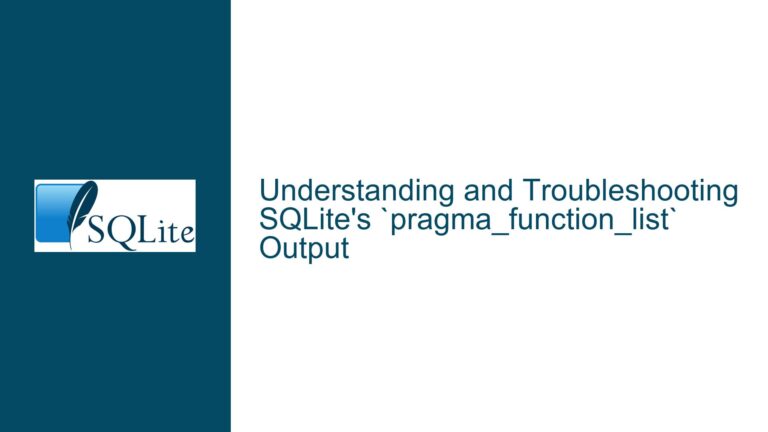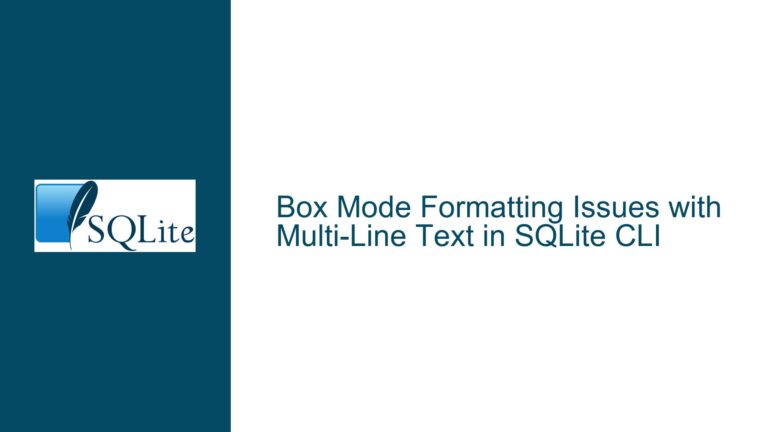Right-Justifying Numerical Columns in SQLite CLI Column Mode
Understanding Column Alignment Behavior in SQLite CLI Output
The SQLite command-line interface (CLI) provides a columnar output mode (.mode column) that formats query results into aligned columns for improved readability. However, numerical columns (e.g., INTEGER, REAL, BOOLEAN) are left-justified by default, which conflicts with conventional data presentation where numerical values are typically right-aligned. This behavior persists even when columns are explicitly defined with specific data types in the schema. For example, consider a table t with columns for geographical coordinates and references:
CREATE TABLE t (
id INTEGER PRIMARY KEY,
longitude REAL,
latitude REAL,
validGeo BOOLEAN GENERATED ALWAYS AS (
typeof(latitude) = 'real' AND
abs(latitude) < 90 AND
typeof(longitude) = 'real' AND
abs(longitude) <= 180
) STORED,
ecoregions_id INTEGER REFERENCES ecoregions(id),
biomes_id INTEGER REFERENCES biomes(id)
);
A SELECT * FROM t; query in column mode produces output where numerical values like longitude, latitude, and validGeo are left-aligned:
id longitude latitude validGeo ecoregions_id biomes_id
-- --------- -------- -------- ------------- ---------
1 -5.0 10.0 1 1 1
2 14.0 5.0 1 1 1
3 23.0 12.0 1
4 -5.0 -10.0 1 2 2
5 -15.0 -25.0 1
6 -160.0 10a.3f 0
7 -15.0 5.0 1 3 2
The lack of right alignment for numerical columns complicates visual scanning, especially when dealing with decimal points, negative signs, or integer identifiers. The root of this issue lies in how the SQLite CLI handles column formatting: it does not automatically infer data types from column definitions or stored values to apply type-specific alignment. Instead, alignment is controlled manually through the .width command, which requires explicit configuration for each column.
Key Factors Preventing Automatic Right-Justification of Numerical Columns
1. Absence of Data Type-Driven Formatting in CLI Output
SQLite’s CLI does not leverage column data types (e.g., INTEGER, REAL) or storage classes (e.g., numeric values) to determine output formatting. The .mode column setting treats all columns as text strings, aligning them based on width specifications rather than semantic type. For instance, the validGeo column—a stored generated BOOLEAN—is represented as 1 or 0 (INTEGER values) but is still left-aligned because the CLI does not distinguish it from generic text.
2. Manual Column Width Configuration Requirement
The .width command is the primary mechanism for adjusting column alignment. Negative values in .width right-justify columns, but these settings are not persisted across sessions or tied to specific databases. For example:
.width -2 -9 -8 -8 -13 -9
This command right-justifies all columns by applying negative width values. However, these settings must be redefined every time the CLI is launched, making them impractical for frequent use cases. The inability to store .width configurations in .sqliterc or database-specific profiles exacerbates the problem.
3. Limitations of the .sqliterc Initialization File
While the ~/.sqliterc file allows users to set default CLI behaviors (e.g., .headers on, .mode col), it cannot dynamically adjust settings based on the active database or table schema. A user might configure global preferences like:
.headers on
.mode col
.timer on
.eqp on
But database-specific formatting requirements—such as column widths for a table with 10 numerical columns versus another with 5—cannot be automated. This forces users to manually execute .width commands after connecting to a database.
4. Mixed Data Types in Columns
Columns containing both numerical and non-numerical data (e.g., latitude with a value 10a.3f in row 6) disrupt alignment consistency. The CLI treats entire columns as text if any row contains non-numerical data, forcing left justification even for predominantly numerical columns.
Strategies for Enforcing Right-Justified Numerical Columns
1. Explicit Column Width Configuration via .width
To right-justify columns, use negative values in the .width command. The magnitude specifies the minimum column width, while the sign controls alignment. For the example table t:
.width -2 -9 -8 -8 -13 -9
This configuration produces:
id longitude latitude validGeo ecoregions_id biomes_id
-- --------- -------- -------- ------------- ---------
1 -5.0 10.0 1 1 1
2 14.0 5.0 1 1 1
3 23.0 12.0 1
4 -5.0 -10.0 1 2 2
5 -15.0 -25.0 1
6 -160.0 10a.3f 0
7 -15.0 5.0 1 3 2
Implementation Steps:
- Execute
.width -<value1> -<value2> ...after connecting to the database. - Determine optimal widths by inspecting column headers and data lengths (e.g.,
longituderequires at least 9 characters to accommodate-160.0). - Use
.showto verify current width settings.
Limitations:
- Manual process; must be repeated per session.
- Column order must remain consistent across queries.
2. Automating .width with Startup Scripts
To avoid manual input, create a SQL script (right_align.sql) containing:
.width -2 -9 -8 -8 -13 -9
SELECT * FROM t;
Execute it via:
sqlite3 mydatabase.db < right_align.sql
For dynamic width calculation, use a shell script to extract column metadata:
#!/bin/bash
DB="mydatabase.db"
TABLE="t"
COLS=$(sqlite3 "$DB" "PRAGMA table_info($TABLE);" | awk -F'|' '{print $2}')
WIDTHS=()
for COL in $COLS; do
LEN=$(sqlite3 "$DB" "SELECT MAX(LENGTH($COL)) FROM $TABLE;")
WIDTHS+=(-$((LEN + 2)))
done
echo ".width ${WIDTHS[@]}" > config.sql
echo "SELECT * FROM $TABLE;" >> config.sql
sqlite3 "$DB" -init config.sql
This script:
- Retrieves column names via
PRAGMA table_info. - Calculates maximum data length for each column.
- Generates a
.widthcommand with negative values. - Executes SQLite with the generated script.
3. Leveraging the -init Option for Persistent Configuration
Store frequently used .width settings in a dedicated file (format.sql):
.width -2 -9 -8 -8 -13 -9
.headers on
.mode column
Launch SQLite with:
sqlite3 mydatabase.db -init format.sql
This approach separates database-specific formatting from global .sqliterc settings.
4. Handling Mixed Data Types and Non-Numerical Values
To ensure right alignment, enforce data consistency:
- Use
CHECKconstraints to validate numerical formats:
CREATE TABLE t (
...
latitude REAL CHECK (typeof(latitude) = 'real'),
...
);
- Clean existing data with
UPDATE:
UPDATE t SET latitude = NULL WHERE latitude GLOB '*[^0-9.-]*';
5. Custom Output Formatting with SQL Functions
For advanced formatting, create SQL functions to pad numerical values:
SELECT
id,
PRINTF("%9.1f", longitude) AS longitude,
PRINTF("%8.1f", latitude) AS latitude,
...
FROM t;
This emulates right justification but requires modifying queries and increases complexity.
Conclusion
Right-justifying numerical columns in SQLite CLI requires a combination of manual configuration, scripting, and data validation. While the CLI lacks built-in type-aware formatting, strategic use of .width, startup scripts, and the -init option can achieve consistent alignment. Users must weigh the trade-offs between automation and flexibility, especially when dealing with dynamic schemas or mixed data types. For large-scale deployments, extending the CLI with custom formatters or migrating to tools with richer formatting support (e.g., sqlite3 + Python Pandas) may be warranted.






